Leclerc’s pain boosts Verstappen’s gain: F1 in France & Hungary
Another double of doom for Ferrari gives rise to Red Bull’s now-mammoth championship advantage. Mark Hughes recaps
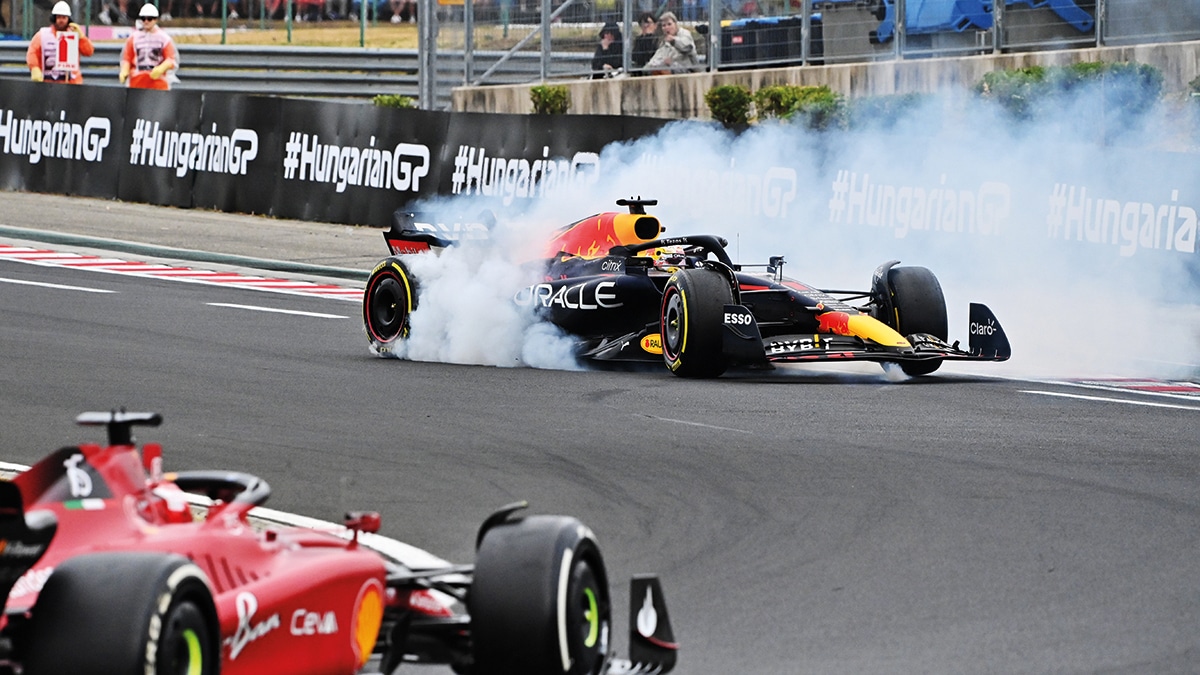
We’ve got a month to order new Pirellis... Use the spare rubber, why not? Max Verstappen clearly didn’t need asking twice after two more wins
DPPI
🇫🇷 2022 French Grand Prix
🇭🇺 2022 Hungarian Grand Prix
The brace of races before F1’s summer shutdown both featured the exact same podium: Red Bull’s Max Verstappen on the top of it, Lewis Hamilton second and his Mercedes team-mate George Russell third. Missing from both was any Ferrari driver, and therein lies a story.
Charles Leclerc spun out of the lead at Paul Ricard, denying that race any tension as he was in a close strategic battle with Verstappen. A week later, around the Hungaroring – a track at which Ferrari was heavily expected to dominate – Carlos Sainz and Leclerc could finish no better than fourth and sixth respectively.
Despite a glittering sequence of pole positions this year, Ferrari headed into the summer break with Leclerc trailing Verstappen by 80 points, their title hopes seemingly forlorn. Reliability issues, bad strategy calls, driver errors and set up misjudgements had all contributed as Verstappen and Red Bull just kept pounding out brilliantly judged victories. With track temperatures of 50°C-plus, the challenge at Ricard was expected to be front tyre degradation. Red Bull and Ferrari had each assessed this challenge differently.
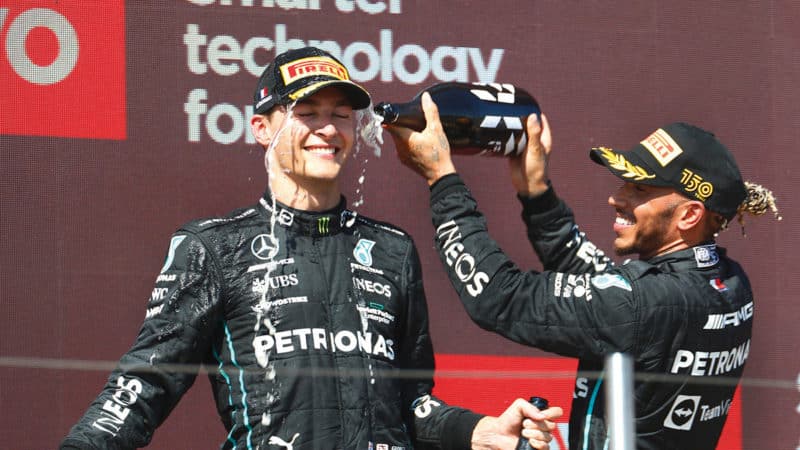
Oddly, seeing both Mercedes drivers on the podium had become a rare sight…
© LAT Images for Mercedes-Benz Grand Prix Ltd
Red Bull had endowed its RB18 with a skinny wing to fly it down the Mistral straight way faster than the Ferrari, which used the medium-downforce wing first introduced in Canada. That gave it way more speed through the circuit’s faster corners, especially the long parabola of Le Beausset, taken in fourth gear, where the Ferrari was 9mph faster than the Red Bull or Mercedes. Leclerc and Sainz were able to go super-deep into there, running to the outer edges before making a sharp ‘V’ turn to rocket out the exit.
Red Bull felt that using up the greater cornering potential of a bigger-winged car would potentially exhaust the rubber much more quickly than its own low-wing set-up around this track in these conditions. Ferrari – having suffered here with graining and wear in 2021 – felt that more downforce would mean more tyre protection. It was a question of which would be the dominant mechanism of tyre deg – thermal degradation or wear. Red Bull was banking on the former, Ferrari the latter.
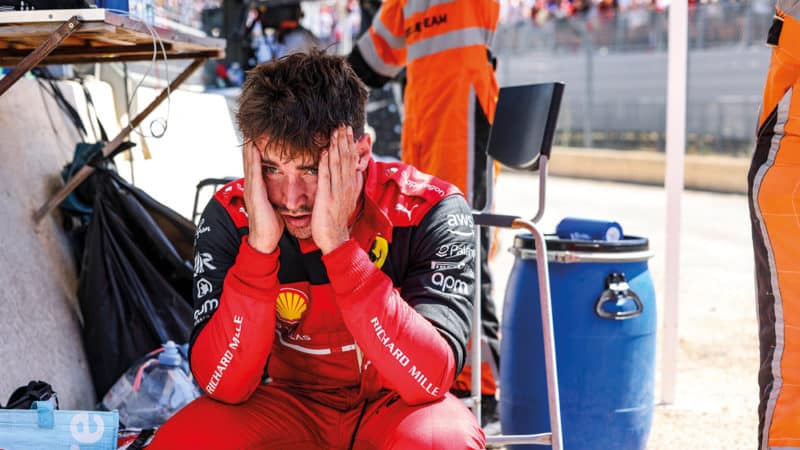
That sinking feeling. Leclerc’s face says it all after crashing out of the lead of the French Grand Prix
DE MATTIA MARC
So as Leclerc and Verstappen led the pack away they were each trying to induce the other into overworking their medium-compound tyres. They set a hard pace doing this and left the pack far behind. That pack was led by Hamilton who had passed Sergio Pérez off the line, with Russell following on behind the second Red Bull. Sainz, starting at the back with his engine penalties, made steady progress through the field on his hard tyres.
The Red Bull’s greater straight-line speed wasn’t enough to get Verstappen past the Ferrari, even with the aid of DRS, because Leclerc was so much faster onto the straight thanks to his greater downforce. The longer that first stint played out with Leclerc and Verstappen both maintaining a hot pace, the more it became evident that the two competing approaches to the tyre conundrum were actually very evenly matched. Leclerc’s tyres were holding on just fine, much to Red Bull’s surprise. It was shaping up into a classic contest on a classic track, as the baking sun competed with the Mistral gusts.
Verstappen had spent the first 12 laps stuck tight into the Ferrari’s slipstream as he tried to force the pace upon Leclerc. But this meant that eventually it was the Red Bull’s front tyres which began to wilt first. Leclerc stepped up the pace by 0.4sec on the 13th lap and Verstappen had no answer. An 0.8sec gap built to 1.8sec in four laps. Leclerc had pulled himself out of DRS range and was starting to get out of the undercut zone too so Red Bull had to act.
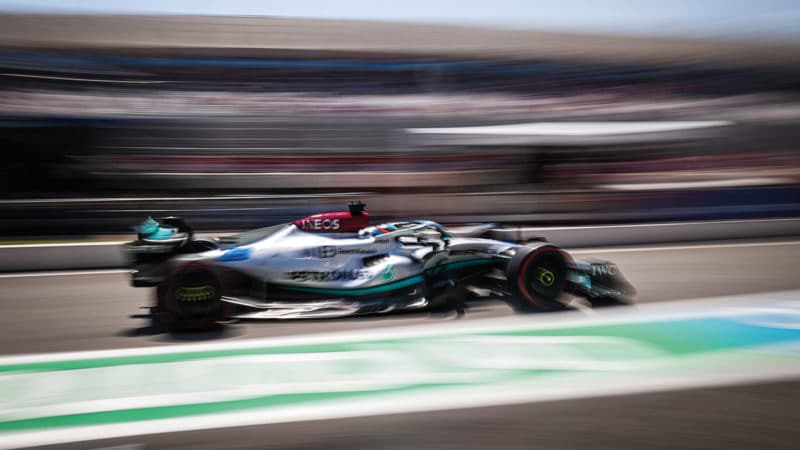
An upgraded Mercedes looked much more on-form, with Russell even bagging a pole
Antonin Vincent / DPPI
It brought Verstappen in on the 16th lap, meaning that the hard tyres he was switched to would have to do the remaining 37 laps. No-one wanted to two-stop because the speed limit part of the pitlane had been extended, meaning each stop would lose you a massive 28sec. It was super-tight whether Leclerc could have remained in front if Ferrari had brought him in on the next lap. But so strong was Verstappen’s out-lap pace it became too risky – and Ferrari instead opted to leave Leclerc out, accepting the immediate net position loss but running for as long as this set of tyres remained good, with the target being lap 22. With a six-lap tyre offset on a long stint, Ferrari was going to try to beat Verstappen that way. It would have involved Leclerc overtaking on track, but with a big tyre offset, maybe it would be possible… Whatever, it was going to be super-tight and totally fascinating.
But we didn’t get to see that battle. Two laps after Verstappen pitted, Leclerc crashed at Le Beausset, that corner where the Ferrari had been so devastating all weekend. Before the race Leclerc had said, “I like an oversteer car but you can’t do that here because it kills the rears so it’s been a difficult weekend. Whenever you get a snap here you get a big snap because there’s so much downforce.”
He got the snap at the most vulnerable point of the circuit, where the car was running up right to the edge of the painted lines. There was no rescuing it and after looping through the run-off it went nose-first into the barrier and couldn’t be extricated as the impact seemed to have damaged the throttle’s drive-by-wire. Even switching it off and back on again, it would give him no throttle and so he was out. So was the safety car, as a result.
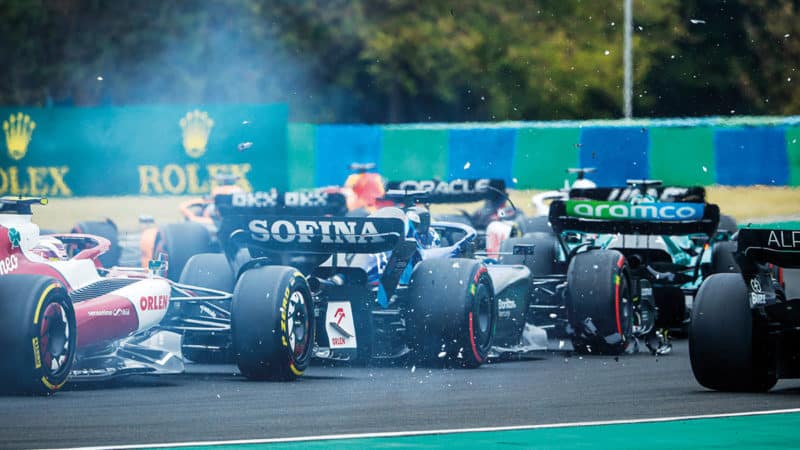
Drama at the start of the Hungarian Grand Prix as Alex Albon’s Williams gets pincered
Antonin Vincent / DPPI
Everyone who hadn’t already stopped dived in now, for the 10sec saving it brought to the pack over a conventional stop. This included Sainz, who had got as far as the midfield Alpines and McLarens. Having started on hards, the safety car had come earlier than ideal for him, meaning a 37-lap stint on mediums, which was a bit of a stretch. Also, there’d been a delay at his stop and he’d been released in front of Alex Albon’s Williams, which locked up in avoidance. This gained Sainz a 5sec penalty. But on the plus side, the safety car meant that the 20sec by which he’d previously been behind Russell and Pérez was now almost nothing – just as soon as he picked off Fernando Alonso and Lando Norris. He did so and on faster tyres than Russell or Pérez (who had switched to the hards) he was able to chase them down, passing Russell around the outside of the flat-in-top Signes.
“Paul Ricard was shaping into a classic contest in the baking French sun”
Verstappen meanwhile faced no threat once Leclerc had crashed out and would just monitor the gap back to Hamilton for the rest of the afternoon. Sainz found Pérez more difficult to pass than Russell on account of the Red Bull’s greater top speed and he’d been unable to pit for a second time to change his old mediums at the ideal moment because the pack had been compacted by the safety car and the position loss would have been too great. Ferrari began considering bringing him in over the late stages – and actually issued the instruction to box just as he had finally succeeded in finding a way by Pérez to go third!
Ferrari reasoned that he would not have had the pace to have pulled out the 5sec penalty on Pérez and Russell and would therefore have finished an official fifth. This way – after taking his penalty in the pits and getting onto new tyres – he could get back up to fifth and take the additional point for the fastest lap he’d inevitably set on the new rubber. Which is what happened. Whether he really would have struggled to get that 5sec before his tyres gave out is one of those great racing imponderables. A late VSC for Zhou Guanyou’s broken-down Alfa Romeo and some FIA systems glitches meant Pérez was jumped on the restart for third by Russell, which in addition to Hamilton’s runner-up spot gave Mercedes its best result of the season.
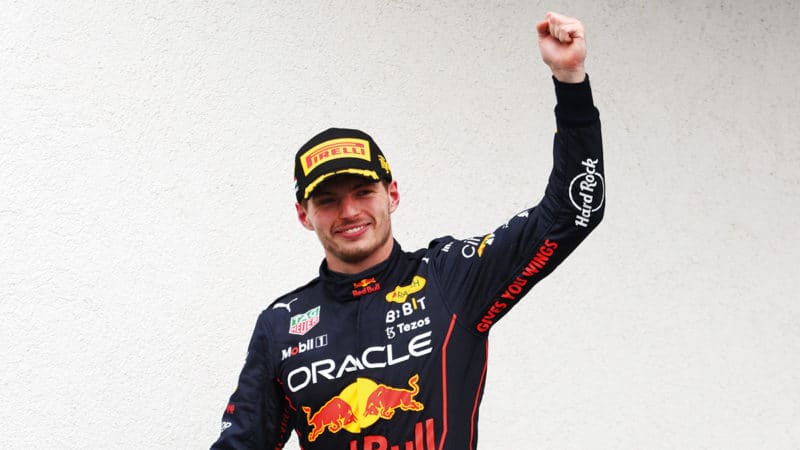
Verstappen has now won eight of the grands prix this season
Bryn Lennon – Formula 1/Formula 1 via Getty Images
What had looked set to have been an extremely hard-fought race was in the end a Verstappen walkover and not for the first time this season Leclerc was distraught – but this time at himself. “It was just a mistake. I feel like I’m performing at probably the highest level of my career since the beginning of the season, but there’s no point performing at that high level if I am doing those mistakes. I think there are 32 points overall I’ve lost with mistakes, 25 today. I think it was likely we were going to win today because we were fast. And seven in Imola with my mistake, so at the end of the year we will count back and if there are 32 points missing, then I know it’s coming from me and I did not deserve the championship. But for the second half of the championship I need to get on top of this if I want to be a world champion.”
That recovery plan didn’t get off to the greatest of starts a week later in Hungary. Sixth place there was not what anyone had in mind for Leclerc as Verstappen repeated his Ricard victory over Hamilton and Russell.
The Ferrari was the fastest car in the sweltering heat of Friday practice but its form took a dive in the much cooler conditions of Saturday and Sunday. But Ferrari was not punished for that as hard as it might have been in qualifying as Red Bull wasn’t around; Verstappen suffered a PU glitch in Q3 and Pérez had failed to make it out of Q2, putting them a respective 10th and 11th on the grid. But that the Ferrari was no longer in its sweet spot of tyre temperatures (and temperature balance front to rear) was evident by the fact Russell pipped Sainz and Leclerc to pole, the first such achievement in his career and the first for Mercedes this year. Had Hamilton’s DRS not failed, causing him to abandon his only new-tyred Q3 lap, he too may have pushed Ferrari back rather than starting P7.
“I reckon I’ve lost 32 points this season through my mistakes”
The cautious starts of Hamilton and Verstappen as they threaded their way carefully past the potentially car-damaging hazards their grid positions had made them susceptible to meant attention in the first stint of what was set to be a two-stop race was focused on Russell leading Sainz and Leclerc. They were pulling out a handy gap over Norris’s McLaren, which had Hamilton on its tail but unable to find a way by for the first 11 laps. Russell had started on softs, knowing in advance he was two-stopping. The Ferraris were on mediums, the team open-minded about how many stops it would make. But one-stopping implied the use of the hard tyre – which neither Ferrari nor Red Bull had tried on Friday. Mercedes had, and knew it wasn’t right. The Red Bull drivers had made their laps to the grid and noted how even the soft tyre wasn’t coming up to temperature and so their initial plan of starting on the hards and one-stopping was abandoned. Like Russell, they started on softs. Hamilton began on the medium so he could run a long first stint and hopefully get some clear air as others pitted in front of him.
Hamilton finally passed Norris for fourth on the 12th lap and was immediately followed through by Verstappen. For a time the Red Bull then closed in on the Mercedes but as its soft tyres began to surrender and Hamilton’s mediums were still good, Red Bull made the decision to come in at the first opportunity, which was lap 16. This effectively undercut Verstappen past Hamilton and was the beginning of his strategically boosted charge to the front (see strategy panel).
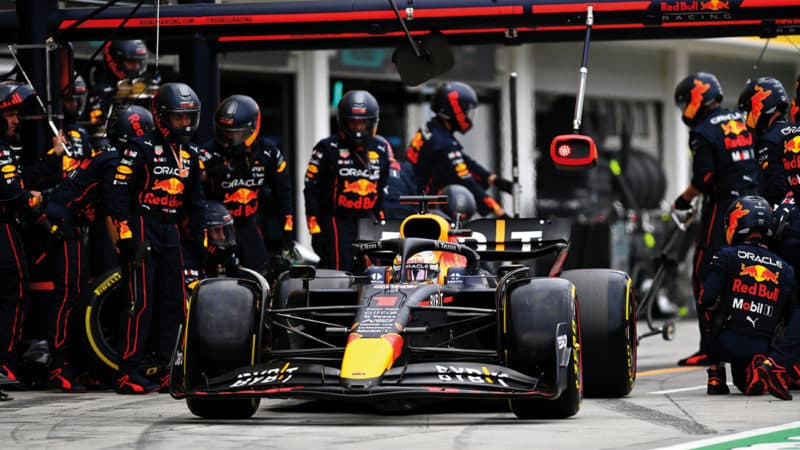
Winning from 10th on the grid was made to look easy by Red Bull and Verstappen in Hungary. An ominous sign…
Getty Images
Also on lap 16, Russell was brought in from the lead as his softs too were beginning to surrender and the medium-shod Ferraris were applying undercut pressure. Sainz was relieved to see Russell pit as he’d been instructed to do the opposite of whatever the Mercedes did. Now he and Leclerc were set to maximise the greater range of their medium tyres, with the intention of one-stopping. But there was a change of plan: a 2sec delay at Russell’s stop put Ferrari in position to overcut Sainz past and he was ordered in on the next lap. Frustratingly for him, there was a delay at his stop too, meaning he was unable to make the overcut work – so he’d come in early for no reward.
Leclerc stopped four laps later and, like Sainz, was fitted with another set of mediums, meaning the one-stop attempt had been abandoned (the regulations oblige you to run at least two compounds). On these he was quicker than Russell and managed eventually to break down the Merc driver’s stern defences and overtake with the help of DRS.
Even from fourth position Verstappen – who had spent this middle stint carefully bringing an over-temperature clutch back to health – was dictating the pattern of this race, for his early second stop on lap 38 applied undercut pressure to Russell and that in-turn applied it to Leclerc. Both came in on the next lap. Sainz stayed out, trying to go long enough to get onto the soft tyre for his final stint.
Verstappen’s out-lap pace on his fresh mediums was stellar and it jumped him past Russell. Team-mate Pérez, yet to pit, moved aside to ease his passage. Russell exited behind Pérez and so was delayed further, with the second Red Bull then coming in a few laps later. Red Bull’s strategists were totally on top of this challenge, aided by Verstappen’s great pace.
“Max made the winning of a race from 10th on the grid look simple”
Because Ferrari had been forced to respond to the Russell undercut with Leclerc when there were still 31 laps to go, it obliged them to fit him with the hard tyre – as the softs could not have lasted that long. The team already suspected this would make for a difficult stint, as it had watched the Alpines of Esteban Ocon and Fernando Alonso find no pace at all on the hard as part of their one-stopping strategy. But surely not as bad as it turned out: “This tyre is sh*t,” reported Leclerc as he twitched his way around the track with no grip or traction. “I could see he was struggling on the hard,” said a delighted Verstappen. Leclerc could hold him off for only two laps.
Later on the same lap Verstappen spun through 360 degrees exiting Turn 13, allowing Leclerc to nip by again. But it was only a temporary reprieve. Such was the Ferrari’s lack of grip on these tyres that Verstappen repeated the pass a few laps later. Sainz was now leading from Hamilton but both needed to make their second stops – and were nowhere near far enough clear of Verstappen to prevent the Red Bull taking the lead when they did stop for a set of softs each. Like that, Verstappen and Red Bull made the winning of a race from 10th on the grid look simple. It was made easier by Ferrari’s lack of pace. On the mediums it was barely any quicker than the Mercedes. On the softs, Sainz was 1sec slower than Hamilton – as we found out in the final stint, where Russell was closing down Leclerc, Sainz was closing down Russell and Hamilton was closing down on them all, setting fastest lap along the way.
When Russell succeeded in getting past Leclerc, Ferrari bailed out of the hard tyre and brought him in for a third stop onto softs, and he rejoined sixth, behind Pérez. Hamilton’s soft-tyre charge took him past both Sainz and team-mate Russell to take a great second.
